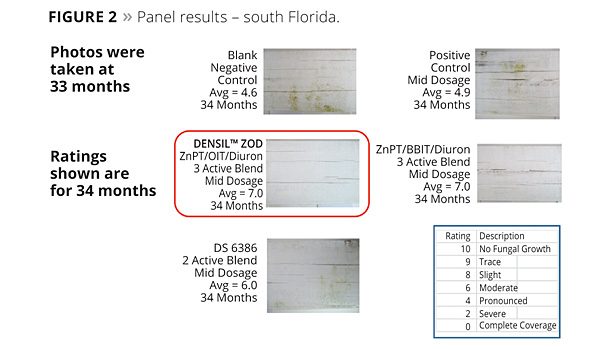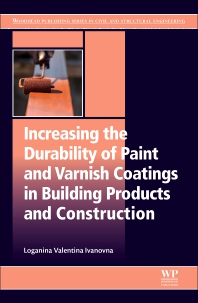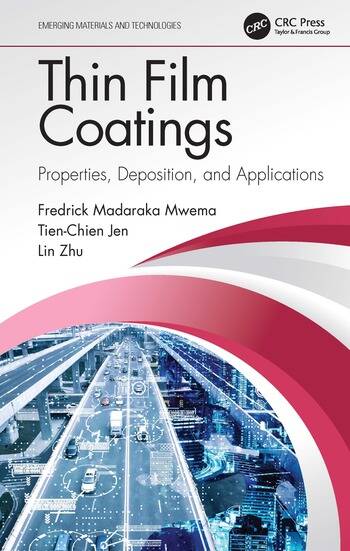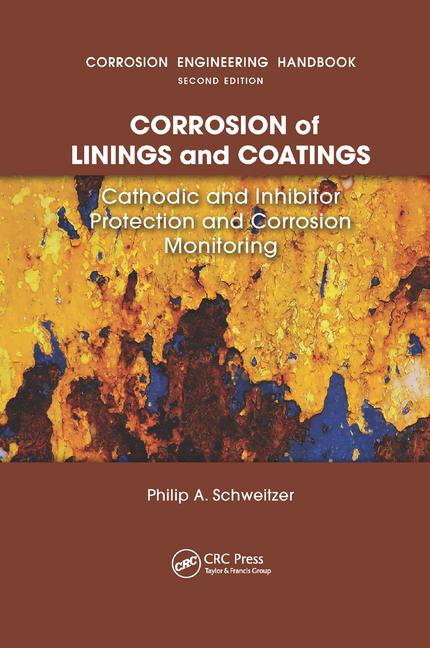The Development of High-Performance Paint Film Biocides
for Architectural Coatings






The paint industry has long been aware of the problems of microbial attack on painted surfaces. Microbial growth can lead to both aesthetic and physical degradation of the coating or painted surface. In addition to the obvious aesthetic effects of mold, mildew and algae growth, physical deterioration by their enzymes can lead to physical degradation. This degradation can include an increase in porosity of the surface coating or a loss of adhesion to the substrate. Moisture penetration can lead to fungal decay of the underlying wood. Biodegradation is not limited to the surface coating or dry paint films; it can also occur during production and storage of the paint.
Coatings formulators face a number of challenges in the selection of dry film biocides. One of the formulator’s main goals is to select dry film biocides so as to achieve broad-spectrum and long-lasting protection of the paint film. One of the challenges is that relatively few biocide active agents are available, and those actives must simultaneously meet multiple requirements. Evaluation of fungicides and algaecides in the context of a paint formulation biocide program invariably involves outdoor exposure testing. Testing of this type involves a complex mix of variables. This is particularly true when it is desired that the results have relevance for more than one geographical region. In addition to consideration of the properties, microbial spectrum and regulatory status of the biocide active agents, there are procedural variables that must be considered. These include the type of substrate to be coated, the coating application method, the panel orientation and direction, the number of replicates, and the inclusion of appropriate controls. Given the number of variables involved, choices must be made to narrow the scope of the panel study experimental design. As constraints for each variable are selected, the resulting matrix forms the study design. One such selection matrix approach is described in this article.
The Microbial Spectrum
Commonly used paint film biocides can be classified according to their microbial spectrum. In other words, they can be classified based on whether their major activity is fungicidal or algaecidal or both. Typical fungicides used in the paint industry for dry film preservation include: carbendazim (BCM), chlorothalonil (CTL), iodopropynylbutylcarbamate (IPBC), octylisothiazolinone (OIT), dichlorooctylisothiazolinone (DCOIT), n-butyl-benzisothiazolinone (BBIT), and zinc pyrithione (ZnPT). Prevention of fungal defacement is typically the focus of paint formulation biocide programs, however algal growth can be a significant problem as well. Most paint film fungicides are not good algaecides, however zinc pyrithione has anti-algal activity as well as anti-fungal activity.
Not every painted surface will require both anti-fungal and anti-algal protection. The impact of local climate will be strongly felt in the type and quantity of the biocide active agents needed to combat the local mix of defacement organisms. On the other hand, local biocide regulations and local environmental public awareness considerations often limit the selection of available active agents or limit the amount of these actives that can be present in a coating. Algal growth requires high humidity and sufficient sunlight to allow for photosynthetic processes. In cases where it is desired to increase the algal resistance of a paint film, the paint film fungicide can be co-formulated with an algaecide. Typical algaecides used in the paint industry for dry film preservation include: 3-(3,4-dichlorophenyl)-1,1-dimethylurea (diuron), 2-(tert-butylamino)-4-(cyclopropylamino)-6-(methylthio)-1,3,5-triazine (Irgarol™), and 2-(tert-butylamino)-4-(ethylamino)-6-(methylthio)-s-triazine (terbutryn).
Water Solubility
In addition to considering the microbial spectrum of the biocides selected for paint film protection, the coatings formulator must also consider the water solubility of these biocides. For exterior coatings, the longevity of the biocide in the film will be related to its water solubility and, therefore, water solubility is an extremely important property.
Examining the water solubility of the commonly used fungicides and algaecides shows that they can be easily clustered together into three groups. There is a group of active agents that have very low water solubility (Group A); a group of active agents that are intermediate in their water solubility (Group B); and a group of active agents that have relatively high water solubility (Group C) (Table 1).
In the conventional model of a paint film, there is a reservoir of fungicidal or algaecidal active agent in the paint film, and there is also some biocide on the surface of the paint. As rain falls on the surface of the paint film, it washes away the biocide on the surface; however the biocide at the surface of the film is replenished by new biocide that is drawn from the reservoir.
When there is a balance between the biocide rate of depletion from the surface and the biocide rate of migration from within the film, then the coating will have long-term protection from microbial attack. When there is not a balance, then the coating will fail. This principle can be illustrated by example.
Consider first the example where the selected biocide has too high a water solubility. The coating will be well protected during an initial period of perhaps 12 to 18 months, but the biocide reservoir in the film will be quickly depleted and the coating will fail after that short initial period. Long-term protection of the coating will not be achieved.
Secondly, consider the example where the selected biocide has too low a water solubility. When a coated surface is first placed in the outdoor environment, there is an initial period where the coating will have high susceptibility to fungal attack. One of the reasons why the susceptibility is greater during this initial period is that some of the small-molecule paint ingredients are leaching from the coating film during this time. These small-molecule ingredients can serve as a nutrient source for the fungi. After a longer period of time in the outdoor environment the nutrients are washed away and the coating becomes less susceptible to fungal attack. If the biocide selected to protect a coating has too low a water solubility, then fungi can start to become established during the initial period of high susceptibility. There is biocide present at the surface of the film, but not enough biocide migrates from the biocide reservoir in the film to prevent the fungi from becoming established. If they become established during the initial period of high susceptibility, then the fungi will continue to attack the coating film, even after the nutrient levels have fallen. Long-term protection of the coating will not be achieved.
Given the above situation, one common strategy for achieving long-term protection of the coating film is to combine a Group A biocide (very low water solubility) with a Group C co-biocide (relatively high water solubility). The more-water-soluble fungicide will migrate quickly through the film and will prevent the fungi from becoming established during the initial period of the coating’s high microbial susceptibility. Over the longer term of outdoor exposure, the less-water-soluble biocide will continue to slowly migrate from the biocide reservoir in the coating film to the coating surface. Since the coating has lower microbial susceptibility after the initial time period, the level of the less-soluble biocide delivered to the coating’s surface is sufficient to prevent microbial defacement. With this strategy, long-term protection of the coating can be achieved.
Given the above considerations, selection of a low-water-solubility fungicide as a base and adding to this a more water-soluble co-fungicide provided our starting point for designing the panel study. Therefore, deciding between carbendazim, chlorothalonil and zinc pyrithione became the initial choice in our selection matrix.
Globally Harmonized System
As described above, local biocide regulations and environmental public awareness considerations often limit the selection of available active agents or limit the amount of these actives that can be present in a coating. One such consideration that is relevant to the U.S. market is the 2015 implementation of GHS.
The United Nations GHS provides a framework for a Globally Harmonized System of hazard communication. Consideration of the three fungicides in the context of GHS reveals that both carbendazim and chlorothalonil are likely to trigger the requirement for health hazard labeling at some concentration. As an example, it is anticipated that the concentration that is likely to trigger the GHS requirement for the health hazard pictogram (e.g., STOT, reproductivity and/or carcinogenicity) will be much lower for carbendazim than it will be for chlorothalonil. Both of these active agents have been used in the agrochemical industry, and their hazards have been studied in that context. In contrast, zinc pyrithione’s presence in paint is unlikely to trigger the GHS requirement for the health hazard pictogram. Therefore, zinc pyrithione was selected as the low-water-solubility base fungicide for our panel study.
Zinc pyrithione is also known as zinc 2-pyridinethiol-n-oxide and is incorporated into Lonza’s Zinc Omadine™ antimicrobial. Zinc pyrithione has a long history of use in anti-dandruff shampoo and other personal care applications. Relative to other commonly used fungicides, zinc pyrithione has superior thermal stability and exceptional alkaline pH stability. Unlike chlorothalonil, zinc pyrithione is not associated with fading or chalking; and therefore, it can be used for both whites and colors. While pyrithiones can act as chelating agents, this tendency can be suppressed. A color-stabilized zinc pyrithione formulation known as Zinc Omadine ZOE antimicrobial was introduced to the U.S. market in August of 2000, and this formulation has since demonstrated good compatibility with a wide variety of latex binders and other common paint ingredients.
Multi-Region Study
Deciding between the higher solubility co-fungicides became the final choice in our selection matrix. In order to evaluate the higher solubility co-fungicides as components of a potential three-active blend, a large multi-region dry film biocide panel study was initiated. For each region the coatings were applied to the substrate most commonly used in that region. The local painting practice was used for application of the paint to the substrate. Biocide active agents with local regulatory authorization were used. The testing in each region included a biocide-free negative control sample and a positive control sample preserved with a locally popular dry film biocide (Figure 1).
As described above, the impact of local climate will strongly impact the mix of defacement organisms that the paint film biocides must contend with. Selection of a high-humidity environment is appropriate for demonstrating that a particular biocide combination provides anti-algal as well as anti-fungal protection. Therefore, for the U.S. portion of the study, southern Florida was selected as the test site; and a supplemental algaecide was included along with each of the fungicide blends in the study. Based on cost/effect and on regulatory availability, Diuron was selected as the supplemental algaecide for the U.S. portion of the study. An initial study was conducted using both wood and cementitious panels. In this initial study a similar ranking was observed for the three active blends on both types of panels. A second follow up study was conducted using only wood panels. Each of these panels was prepared with one coat of primer and two coats of test paint. A laboratory-made standard acrylic flat exterior paint was used for the study.
What was observed during the study was that all of the three active blends performed well. Looking at overall performance, the three active blends with OIT as the co-fungicide performed better than the combinations with either IPBC or BBIT. However, the combinations with either IPBC or BBIT still showed good performance (Figure 2).
Based on the results from our panel study, Lonza is launching two new dry film biocide formulations. The first product, Densil™ ZOD™ antimicrobial is now EPA registered. It is available in the United States, and it will also be available in several other global markets. The second product, Densil FAZ antimicrobial is being introduced specifically for the Asian region. Relative to Densil ZOD, the Densil FAZ product has a higher ratio of the supplemental algaecide to the fungicidal actives. Both Densil ZOD and Densil FAZ provide long-term, broad-spectrum microbial protection for paint films. Both products use Lonza’s Zinc Omadine antimicrobial with proprietary color stabilization technology.
Conclusion
In summary, long-term, broad-spectrum microbial control on painted surfaces can be achieved by careful selection of biocide active agents, including consideration of their properties, microbial spectrum and regulatory status.
Looking for a reprint of this article?
From high-res PDFs to custom plaques, order your copy today!











